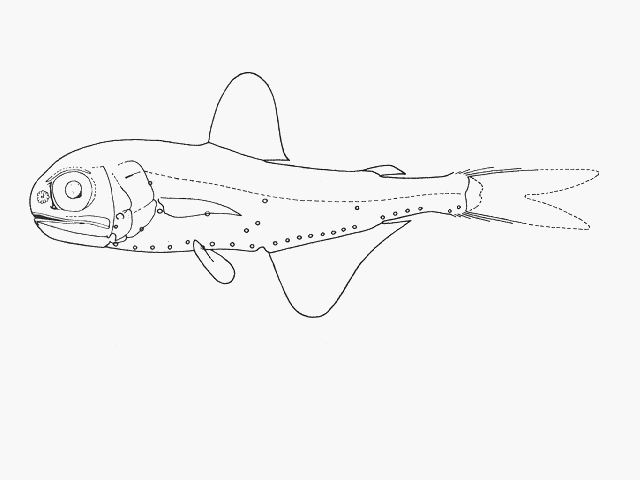Dasyscopelus
asper
(Richardson,
1845)
Prickly lanternfish
View all media / Upload your photos and videos
Expand all
Classification / Names
Teleostei (teleosts) > Myctophiformes (Lanternfishes) >
Myctophidae (Lanternfishes)
> Myctophinae
More on author:
Richardson.
Environment / milieu / depth range / climate zone / distribution range
Distribution
Western Atlantic: 20°N to Brazil including the Gulf of Mexico, with expatriates in the slope water region. Eastern Atlantic: Mauritania to South Africa (Agulhas water pockets). Northwest Atlantic: Canada (Ref. 5951). Indo-Pacific: north and south equatorial currents and equatorial countercurrents, and in the east Australian and Agulhas currents. Also in the Eastern Central Pacific (Ref. 9325). Larvae found in Taiwan Strait (Ref. 43570). South China Sea and East China Sea (Ref. 74511).
Maps

Dasyscopelus asper / Native range
AquaMaps Data sources:
GBIF
OBIS
This map was computer-generated and has not yet been reviewed.

Dasyscopelus asper / Suitable habitat
AquaMaps Data sources:
GBIF
OBIS
This map was computer-generated and has not yet been reviewed.

Dasyscopelus asper / Point map
AquaMaps Data sources:
GBIF
OBIS
This map was computer-generated and has not yet been reviewed.

Dasyscopelus asper / Year 2050
AquaMaps Data sources:
GBIF
OBIS
This map was computer-generated and has not yet been reviewed.
Length at first maturity / Size / Weight / Age
Short description
Biology
Neustonic to mesopelagic (Ref. 58302). High-oceanic, nyctoepipelagic at the surface and down to 125 m. Found between 425-750 m during the day. Sexually mature from about 65 mm (Ref. 4479). Proximate analysis (excluding head) reveals that lipid content is 2.0 % in fresh body weight and wax ester is 17.2 % in total lipids (Ref. 9193).
Main reference
Hulley, P.A. 1990 Myctophidae. p. 398-467. In J.C. Quero, J.C. Hureau, C. Karrer, A. Post and L. Saldanha (eds.) Check-list of the fishes of the eastern tropical Atlantic (CLOFETA). JNICT, Lisbon; SEI; Paris; and UNESCO, Paris. Vol. 1. (Ref. 4479)
IUCN Red List Status (Ref. 125652)
Least Concern (LC); date assessed: July 11 2012
CITES (Ref. 123416)
Not Evaluated
CMS (Ref. 116361)
Not Evaluated
Threat to humans
Harmless
More information
- Countries
- FAO areas
- Ecosystems
- Occurrences
- Introductions
- Stocks
- Ecology
- Diet
- Food items
- Food consumption
- Ration
- Common names
- Synonyms
- Metabolism
- Predators
- Ecotoxicology
- Reproduction
- Maturity
- Spawning
- Spawning aggregation
- Fecundity
- Eggs
- Egg development
- Age/Size
- Growth
- Length-weight
- Length-length
- Length-frequencies
- Morphometrics
- Morphology
- Larvae
- Larval dynamics
- Recruitment
- Abundance
- References
- Aquaculture
- Aquaculture profile
- Strains
- Genetics
- Allele frequencies
- Heritability
- Diseases
- Processing
- Mass conversion
- Vision
- Pictures
- Stamps, Coins Misc.
- Sounds
- Ciguatera
- Speed
- Swim. type
- Gill area
- Otoliths
- Brains
Estimates based on models
Preferred temperature (Ref. 123201): 2.9 - 10.4, mean 6.6 °C (based on 1525 cells).
Phylogenetic diversity index (Ref. 82804): PD50 = 0.5 [Uniqueness, from 0.5 = low to 2.0 = high].
Bayesian length-weight: a=0.01023 (0.00564 - 0.01857), b=3.25 (3.09 - 3.41), in cm total length, based on LWR estimates for this species & (Sub)family-body (Ref. 93245).
Trophic level (Ref. 69278): 3.7 ±0.4 se; Based on food items.
Resilience (Ref. 120179): High, minimum population doubling time less than 15 months (Preliminary K or Fecundity.).
Fishing vulnerability (Ref. 59153): Low vulnerability (10 of 100).
Nutrients (Ref. 124155): Calcium = 0 [0, 0] mg/100g; Iron = 0 [0, 0] mg/100g; Protein = 0 [0, 0] %; Omega3 = 0 [0, 0] g/100g; Selenium = 0 [0, 0] μg/100g; VitaminA = 0 [0, 0] μg/100g; Zinc = 0 [0, 0] mg/100g (wet weight);

